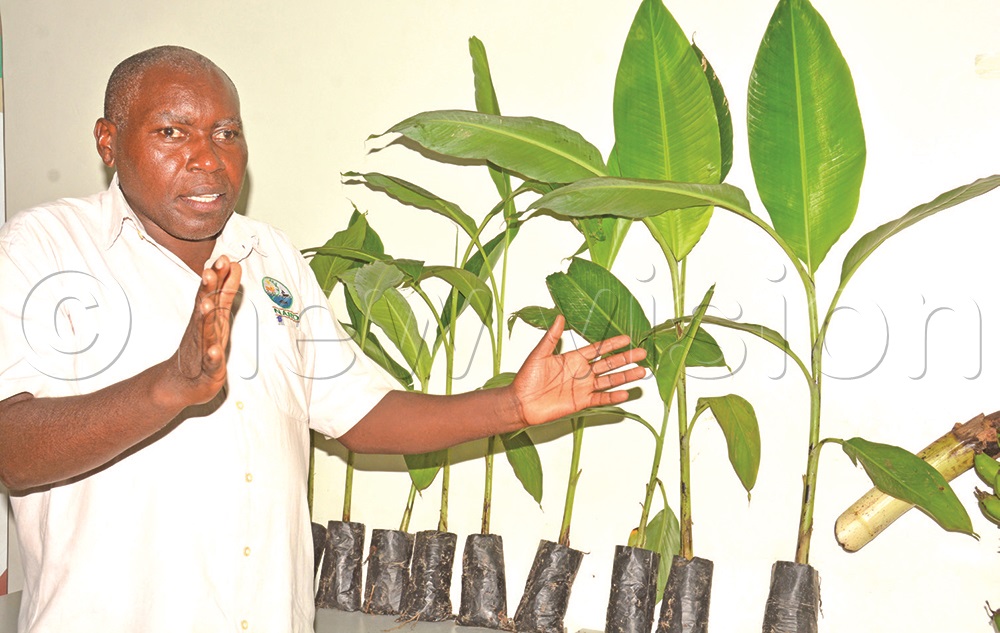At the start of his farming journey, Godfrey Sanga used to grow indigenous bananas.
However, the enterprise was plagued by various challenges that included pests, diseases and low yields that led to poor returns.
All this changed in 2023, when the farmer in Bulwadda village, Nakaseke district, was introduced to NAROBAN6 during the crop’s field trials.
It is a banana variety that was developed by researchers from the National Banana programme, under the National Agriculture Research Organisation (NARO).
“We were taught how to grow the bananas by researchers to get high yields. During the dry spell, indigenous varieties don’t yield much, but NAROBAN6 produces a big bunch,” Sanga said.
He noted that researchers highlighted that the planting holes should measure 3ftx3ft for places where the soils are hard and 2ftx2ft for soft soils.
Other practices included mixing one basin of cow dung with one basin of the top soil collected while digging the pits and applying this in the hole when planting the bananas. Regarding maturity, Sanga says they start fruiting at eight months.
The fruit takes three to five months to mature, after which it is ready for consumption. Listing the benefits of the crop, the farmer said from quarter-an-acre, he harvests an average of 15 bunches, four times a year.

“In Nakaseke, I sell each bunch at sh25,000. But when I take them to Nakasero Market, I sell each bunch at sh50,000,” Sanga said.
The bananas are soft and have a good taste, he added. Besides, when cooked, they have a dark yellow colour, usually preferred by consumers, Sanga said.
On how best to cook the bananas, Teopista Nansubuga, who is Sanga’s mother and also grows the variety, explained that just like any other banana, when not wel they will harden.
The bananas are also good for making katogo, she added.
Nansubuga also said the money earned from bananas is used to provide basic needs for her grandchildren and her own health.
Benefits of NAROBAN6
With field trials done, NAROBAN6 was released recently to farmers through the National Agriculture Research Laboratories, Kawanda.
It was developed by researchers under the National Banana Programme in Kawanda, led by Dr Alex Barekye, with support from International Institute of Tropical Agriculture (IITA).
According to Barekye, NAROBAN6, also known as NARITA17, is a newly released banana that was developed by Entukula Matooke.
In terms of bunch weight, he said, NAROBAN6 weighs 26kg compared to 17.2kg of NAROBAN5. NAROBAN6 has a shorter cycling period than other banana hybrids.
It takes 10 months from planting to flowering and four months from flowering to harvest.
The crop is resistant to nematodes that attack the roots and destroy the feeding system, making the plant weaker.
It is also tolerant to weevils and resistant to Fusarium wilt and black sigatoka that affect the leaves of bananas leading to low yields, Barekye adds.
“Banana weevils attack the comb of the plant, rendering it weak and easily destroyed by heavy winds. These effects reduce the plantation life of bananas. However, the NAROBAN6 can stand up to more than 10 years of banana plantation span,” he noted.
To access the seed, Barekye said it should be sourced from designated sources, such as the Zonal Agriculture Research and Development Institutes, National Research stations and certified seed companies, dealing in seed.
Why banana research?
According to Dr Robooni Tumuhimbise, the director of research at the National Agriculture Research Laboratories, Kawanda, more than 20 million people in Uganda depend on bananas for food and income security.
However, average production has remained low, despite significant efforts put into generating and promoting technologies against numerous production constraints.
Some of the challenges to banana production among farmers include diseases, such as black sigatoka and bacterial wilt and pests like weevils and nematodes that are being addressed through the newly released banana variety.
Tumuhimbise added that diseases, such as Fusarium wilt, are not controllable by traditional practices and thus opting for resistant varieties, hence the development of NAROBAN6.





